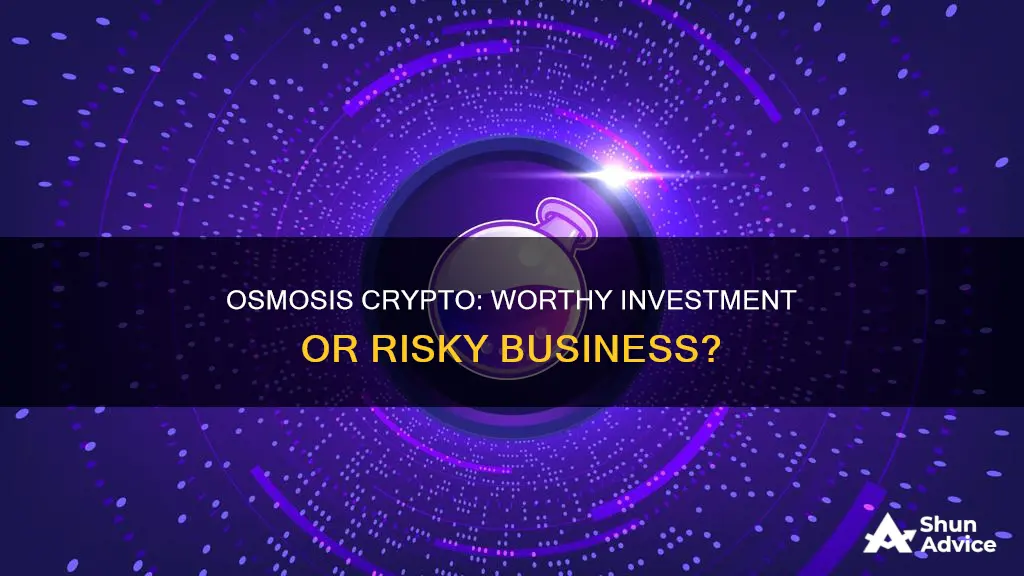
Osmosis (OSMO) is a decentralised exchange (DEX) for the Cosmos ecosystem, a network of interoperable blockchains. It is a high-performance blockchain ecosystem with the largest interchain DEX, a smart contract programmable blockchain, and DeFi functionalities. Osmosis has a growing community of users and averages around $22 million in 24-hour trading volume. The DEX has $203.7 million in total value locked with +1000 interchain transfers. The Osmosis blockchain protocol has three key strengths that set it apart from other AMM money market protocols, including customizable liquidity pools, coordination between stakeholders, and the idea of AMMs as serviced infrastructure. The OSMO token is used to pay for network fees, can be staked to secure passive rewards, and serves a vital role in launching pools where it serves as the base asset. The current market cap of Osmosis is $334.06 million, and it is ranked #131 in live coin rankings.
What You'll Learn

Osmosis's unique features
Osmosis (OSMO) is a decentralised exchange (DEX) native coin for the Cosmos blockchain network. It is the first native automated market maker (AMM) on the network, allowing for decentralised finance (DeFi). Osmosis has several unique features that set it apart from other AMM money market protocols:
Customisable Liquidity Pools: Osmosis allows liquidity providers (LPs) to adjust factors such as slippage and transaction fees, giving them more flexibility than other DEXs like Uniswap. This enables LPs to self-identify opportunities and react to them by adjusting parameters.
Coordination Between Stakeholders: Osmosis incentivises long-term liquidity provision and prevents possible vampire attacks from other protocols by giving liquidity providers with more skin in the game a bigger say in the strategic direction of the pool. Liquidity pool shares are used to calculate both fractional ownership and the right to participate in decision-making.
AMMs as Serviced Infrastructure: With the increase in DeFi product complexity, Osmosis provides AMM creators with the option to define the bonding curve value function and reuse the rest of the infrastructure. This allows for a compromise between efficiency and non-optimal bonding curves.
Superfluid Staking: As an appchain DEX, Osmosis has greater control over the full blockchain stack, enabling the development of Superfluid Staking. This improvement to Proof-of-Stake security allows the underlying OSMO in a liquidity position to add to chain security and earn staking rewards.
Transaction Mempool Shielded with Threshold Encryption: The customisability of appchains also allows for the development of a transaction mempool shielded with threshold encryption, reducing harmful MEV on Osmosis.
Bitcoin for All: Who Can Invest?
You may want to see also

Osmosis's growth linked to Cosmos
Osmosis is a decentralised exchange (DEX) and an automated market maker (AMM) within the Cosmos network. It is the first native AMM on the Cosmos blockchain network, which enables decentralised finance (DeFi) on the network.
Osmosis is the eighth blockchain in the Cosmos network to enable the Inter-Blockchain Communication Protocol (IBC), which allows applications based on the Tendermint consensus algorithm to interact with each other. This means Osmosis can operate between chains.
Osmosis's success is closely linked to the Cosmos network. As a DEX, Osmosis has greater control over the full blockchain stack than DEXs that must follow the code of a parent chain. This has enabled the development of Superfluid Staking, an improvement to Proof-of-Stake security. The customisability of appchains also allows for the development of a transaction mempool shielded with threshold encryption, which will greatly reduce harmful MEV on Osmosis.
Osmosis's vision is to build a cross-chain native DEX and trading suite that connects all chains over IBC, including Ethereum and Bitcoin. It has invited external developers to create a bespoke DEX ecosystem that includes lending, credit, margin, fiat on-ramps, Defi strategy vaults, NFTs, stablecoins, and more.
Osmosis's growth is reflected in its trading volume and total value locked (TVL). In December 2023, Osmosis achieved a monthly trading volume of $1.121 billion, marking the first time the trading volume on the DEX had surpassed $1 billion since May 2022. This surge in activity caused the value of the OSMO token to increase by 121.97% over 30 days.
Osmosis's TVL hit a record $1.21 billion on 11 January, according to data from Defi Llama. This growth is attributed to the multiple tokens in the Cosmos ecosystem hitting new highs. For example, ATOM, the most recognisable asset from Cosmos, hit a daily high of $43.64 on 7 January, just a dollar below its all-time high. Osmosis' second native token, ION, also hit a new high at $16,500 on 11 January.
Osmosis's growth is also linked to the increased attention Cosmos has directed toward Ethereum Virtual Machine (EVM) compatibility and cross-chain bridges. Evmos, a current project in development, is working on becoming the first IBC-compatible EVM-based chain and is currently supporting ERC-20 tokens on its testnet. Injective, a Layer 1 protocol, is also developing cross-chain bridges for Cosmos-based projects and is working on support for OSMO. As cross-chain bridges come online, Osmosis has the potential to see further increases in trading volume and TVL as the main DEX for the Cosmos ecosystem.
Aioz Crypto: Smart Investment or Risky Gamble?
You may want to see also

Osmosis's price outlook
Osmosis (OSMO) is a decentralised exchange (DEX) for the Cosmos ecosystem, a network of interoperable blockchains. It also supports non-IBC assets from the Ethereum and Polkadot ecosystems.
The Osmosis blockchain protocol has three key strengths that set it apart from other AMM money market protocols. Firstly, it has customisable liquidity pools. Secondly, coordination between stakeholders is made easier because liquidity pool shares are used to calculate the fractional ownership of a liquidity pool and the right to participate in strategic decision-making. Finally, Osmosis introduces the idea of "AMMs as serviced infrastructure", allowing AMM creators to define the bonding curve value function and reuse the rest of the infrastructure using Osmosis' products.
The OSMO token was released with an initial supply of 100 million tokens, allocated evenly between airdrops to ATOM holders and a strategic reserve. New tokens are released at the end of each daily epoch and follow a "thirdening" schedule, meaning token issuance is cut by a third each year.
Osmosis has a growing community of users. According to company documentation, the network averages around $22 million in 24-hour trading volume. The DEX has $203.7 million in total value locked with +1000 interchain transfers.
The current price of Osmosis is $0.49 per OSMO with a 24-hour trading volume of $23.64 million. The all-time high of Osmosis is $11.21. This all-time high is the highest price paid for Osmosis since its launch. The current market cap of Osmosis is $334.06 million.
The Osmosis price prediction for 2022 from CoinCodex suggested that the coin value could have climbed by 48% to $2.42 on 27 November 2022. DigitalCoinPrice anticipated a gradual price rise, with the coin averaging $1.81 in 2022 and $4.51 in 2025. Its osmosis price prediction for 2030 said this value would have hit $9.40. PricePrediction.net’s OSMO forecast was the most bullish for the long term, estimating that the price could average $1.90 in 2022, $5.67 in 2025, and $34.64 in 2030.
Basic Attention Token: Worthy Investment or Just Hype?
You may want to see also

Osmosis's safety
Osmosis (OSMO) is a decentralised exchange (DEX) for the Cosmos ecosystem, which is a network of interoperable blockchains connected via the Inter-Blockchain Communication Protocol (IBC). It is a high-performance blockchain ecosystem that includes the largest interchain DEX, a smart contract programmable blockchain, and DeFi functionalities.
Safety Features
Osmosis has a number of features that contribute to its safety:
- Customisable liquidity pools: Osmosis allows liquidity providers (LPs) to adjust parameters such as slippage and transaction fees, giving them more flexibility and control compared to other protocols.
- Superfluid staking: This is a security enhancement to the Proof-of-Stake model, allowing users to stake OSMO tokens and receive pool rewards while the underlying OSMO is staked, improving security and ROI.
- Sovereign proof-of-stake blockchain: Osmosis operates on its own validator set, providing additional security.
- Governance system: Anyone can stake their OSMO to propose and vote on network upgrades or changes, allowing users to have a say in the direction of the network.
- Non-custodial and mobile wallet security: Osmosis offers a range of wallet options, including the Leap wallet and the Trust Wallet, providing non-custodial and mobile security for crypto assets.
- Development team's quick response to security breaches: In June 2022, when the Osmosis swap feature was hacked, the developers and network nodes worked together to halt the attack within 12 minutes, preventing further losses.
Risks to Consider
It is important to note that investing in cryptocurrencies, including Osmosis's native token OSMO, carries significant risks due to their highly volatile nature. The value of OSMO has fluctuated over time, reaching an all-time high of $11.21 in early 2022 but also experiencing a precipitous drop in value by mid-2022 due to events related to the Cosmos-based Terra project.
Additionally, the future of Cosmos as a leading interoperability network is uncertain due to various challenges and criticism regarding a lack of transparency. This could potentially impact the value and safety of Osmosis, as it is built within the Cosmos ecosystem.
Therefore, it is crucial for investors to carefully consider their risk tolerance and conduct thorough research before investing in Osmosis or any other cryptocurrency.
Is Bitcoin a Worthy Investment?
You may want to see also

Osmosis's use cases
Osmosis (OSMO) is a decentralised exchange (DEX) for the Cosmos ecosystem, which is a network of blockchains. As a DEX, Osmosis allows for the exchange of assets without the need for intermediaries like brokers or banks.
Customisable Liquidity Pools
Osmosis allows for customisable liquidity pools with multiple tokens and unequal ratios. This flexibility is designed to meet the needs of a maturing DeFi market, where liquidity providers (LPs) and arbitrageurs can self-identify opportunities and react by adjusting parameters. LPs can adjust factors like slippage and transaction fees.
Sovereign Ownership of Liquidity Pools
Osmosis gives staked liquidity providers sovereign ownership over their pools. Through the pool governance process, they can adjust parameters based on competition and market conditions. This incentivises long-term liquidity provision and prevents possible "vampire attacks" from other protocols.
AMMs as Serviced Infrastructure
With the increasing complexity of DeFi products, Osmosis provides an option for AMM creators to define the bonding curve value function and reuse the rest of the infrastructure using Osmosis's products. This allows for custom-curve AMMs, dynamic adjustments of swap fees, and multi-token liquidity pools.
Superfluid Staking
As an appchain DEX, Osmosis has greater control over the full blockchain stack. This has enabled the development of Superfluid Staking, an improvement on Proof-of-Stake security. Superfluid staking allows the underlying OSMO in a liquidity position to add to chain security and earn staking rewards.
Transaction Mempool Shielded with Threshold Encryption
The customisability of appchains also allows for the development of a transaction mempool shielded with threshold encryption. This feature significantly reduces harmful MEV (Miner Extractable Value or Maximally Extractable Value) on Osmosis.
Cross-Chain Functionality
Osmosis is the eighth blockchain in the Cosmos network to enable the Inter-Blockchain Communication Protocol (IBC). This allows Osmosis to operate between chains and provide a platform for token swaps, liquidity pools, staking, and governance.
Osmosis's vision is to build a cross-chain native DEX and trading suite that connects all chains over IBC, including Ethereum and Bitcoin.
Celr Coin: A Smart Investment Decision?
You may want to see also
Frequently asked questions
Osmosis (OSMO) is a decentralised exchange (DEX) for the Cosmos ecosystem, which is a network of interoperable blockchains. It is also a Layer 1 App Chain DeFi protocol within the Cosmos ecosystem.
Osmosis operates on a unique model that allows for customisable liquidity pools. Liquidity providers can adjust parameters such as slippage and transaction fees. It also introduces the concept of "AMMs as serviced infrastructure".
Osmosis provides a suite of trading functionalities, including lending, credit, margin, fiat on-ramps, DeFi strategy vaults, NFTs, stablecoins, and more. It also intends to reduce harmful MEV through the development of a transaction mempool shielded with threshold encryption.
Whether Osmosis is a good investment depends on your personal circumstances and risk tolerance. Cryptocurrencies are volatile assets with a high-risk reward profile, especially newer coins like OSMO. You should evaluate the level of risk you are prepared to accept before investing and never invest money that you cannot afford to lose.
You can buy Osmosis (OSMO) on several major crypto exchanges, including Binance, Crypto.com, KuCoin, Gate.io, and MEXC.







